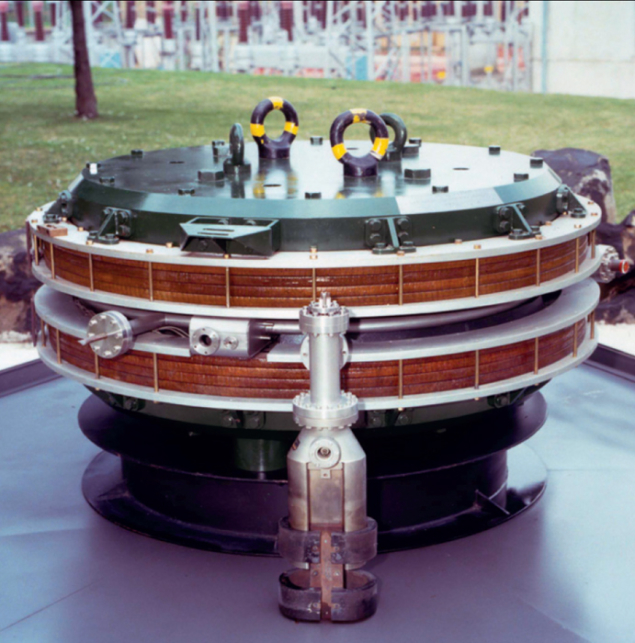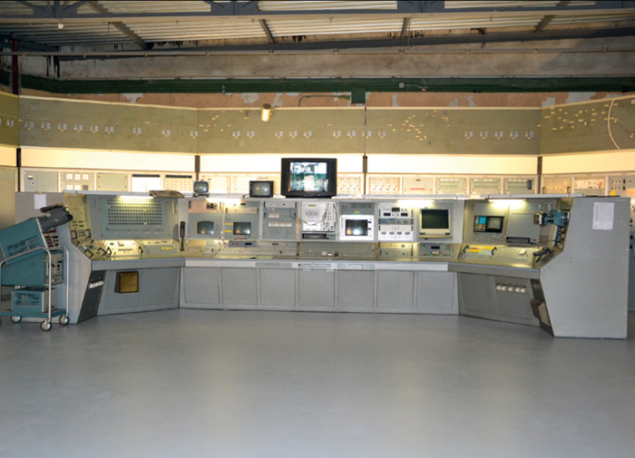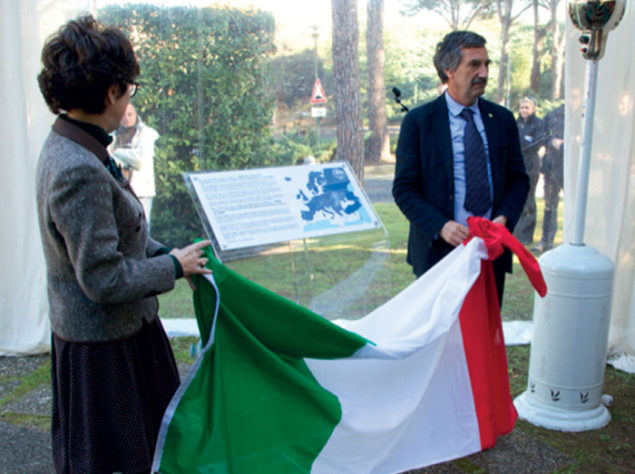The first electron–positron collisions at a storage ring were observed 50 years ago.

Image credit: LAL.
The story of the world’s first electron–positron storage ring, the Anello di Accumulazione (AdA), started in Italy at INFN’s Frascati National Laboratory (LNF). Built there under the leadership of Bruno Touschek, it stored its first beams in February 1961. A year later, the machine travelled to France, to the Laboratoire de l’Accélérateur Linéaire (LAL) in Orsay – now part of CNRS/IN2P3 and Paris Sud University – so that it could benefit from the new state-of-the-art linac as injector. The first electron–positron collisions were observed and studied there from late 1963 to spring 1964, laying the foundations for a technique that would revolutionize investigations of fundamental particles and their interactions.
To celebrate this anniversary, LAL and LNF organized a special meeting in the series of Bruno Touschek Memorial Lectures, BTML 2013, which took place at LAL on Friday 13 September – a date chosen to take advantage of the following weekend of European Heritage Days in France. Associated public events took place during the three days, including a public lecture on “LAL and CERN” in the evening of 13 September and open days at LAL on 14–15 September.
The special BTML 2013 meeting began with a talk about Touschek and the memorial lectures. This was followed by recollections from LAL’s Jacques Haïssinski – who did his doctoral thesis work at AdA – and by the first showing of a new film on the period when AdA was at LAL. A second session focused on accelerators, their applications in society and the future programmes for both LAL and LNF. The afternoon’s more ceremonial events took place in the Pierre Marin hall, which hosts the Anneau de Collisions d’Orsay (ACO) – AdA’s successor at LAL (1965–1988) and now the core of the Sciences ACO museum. Events included the inauguration at the museum of the historic linac’s restored control room, which has been moved and reassembled exactly as it was.

Image credit: LNF/INFN.
The linac at LAL delivered its first beam of electrons, at 3 MeV, near the end of 1958. By 1964 the beam energy reached 1.3 GeV – a world record for electron linacs at that time. However, from 1963, the accelerator was also equipped to deliver a positron beam, and this would become a valuable tool in the implementation of collider and storage rings at LAL, beginning with the pioneering studies on AdA.
AdA and LAL become EPS Historic Sites
In a ceremony on 5 December at the LNF, the European Physical Society (EPS) declared AdA an EPS Historic Site. The ceremony, which was chaired by LNF’s director, Umberto Dosselli, featured talks by Giorgio Salvini, LNF’s director in 1961 at the time that construction of AdA was agreed, and Carlo Bernardini, who gave a personal recollection of the main steps in building AdA and the exciting atmosphere pervading the LNF at that time. INFN’s president, Fernando Ferroni, also had the opportunity to comment briefly on the present status of the laboratory and its future perspectives. EPS vice-president, Luisa Cifarelli, spoke on the EPS Historic Sites initiative and also described the society’s foundation, development and links with INFN. The EPS Historic Site plaque was then unveiled by Ferroni and Cifarelli. The programme continued in the afternoon with the Frascati edition of BTML 2013, in which Samuel Ting, of the Massuchusetts Institute of Technology, presented the latest results from the Alpha Magnetic Spectrometer, which is studying antiparticle production in cosmic rays (CERN Courier October 2013 p22). CERN’s Luigi Rolandi then gave a public lecture on the recent discovery of a Higgs boson.
Two months earlier, during the special edition of BTML 2013, LAL and the LURE complex became the 8th EPS Historic Site. AdA’s shutdown at LAL was followed by the start-up of the ACO ring in 1965, allowing important measurements in accelerator and particle physics. Later, ACO and then SuperACO became leaders in the use of synchrotron light for other research fields, such as materials science and chemistry. The Laboratoire pour l’Utilisation du Rayonnement Électromagnétique (LURE) was created in 1973 to develop this activity, becoming independent from LAL in 1985. Today, LURE has led to the SOLEIL synchrotron on the Saclay plateau, a first-class third-generation light source.
The story of AdA
At the start of the 1960s, several groups worldwide were following up ideas for electron–electron and proton–proton colliders. In contrast, Touschek’s vision was to make electrons and positrons collide and annihilate in such a way that the centre of mass of the system is at rest in the laboratory frame and to produce time-like photons with enough energy to excite resonant modes of the vacuum corresponding to the masses of the vector mesons. With the blessing of Giorgio Salvini, LNF’s director at the time, a small group of inspired physicists started work on designing and building a prototype electron–positron storage ring, which they named AdA (Bernardini 2004).

Image credit: LAL.
AdA consisted of a ring-shaped vacuum chamber, 160 cm in diameter, which was embedded in a magnet of 8.5 tonnes to keep beams circulating with energies up to 200 MeV. Challenges included maintaining a high vacuum to guarantee the lifetime of the beam and working out how to inject both electrons and positrons. Injection was achieved through the conversion of γ rays in a tantalum plate installed in the vacuum chamber, the γ rays being produced by bremsstrahlung from the electron beam of LNF’s electron synchrotron. The first stored electrons and positrons circulated on 27 February 1961, but difficulties in siting AdA close to the synchrotron meant that the stored intensities were low and proof of collisions had to wait until the storage ring was taken to Orsay.

Image credit: LAL.
The move to LAL stemmed from a visit to Frascati in the summer of 1961 by Pierre Marin, who found AdA to be un vrai bijou. By the end of the year, preliminary studies for a 1.3 GeV electron–positron storage ring at LAL had started, but the project was soon considered too close to the proposal for the ADONE collider at Frascati. In early 1962, a small group of scientists and engineers from Orsay went to Frascati to discuss, among other items, ways of operating AdA at the Orsay linac to benefit from the high beam intensity and easier photo-injection from the linac. At the beginning of July, AdA was packed onto a lorry and set off across the Alps with a fully evacuated beam pipe, and batteries to last about three days to power the vacuum pumps and avoid losing the high vacuum that had taken months to obtain. A month later, the collider was installed in Orsay – although not without incident. While being positioned by a crane, AdA was almost smashed against a wall. Later, a heavy detector tipped over while being moved close to the ring and broke Marin’s foot.

Image credit: INFN/LNF.
In Orsay, in a series of runs between December 1963 and April 1964, collisions were finally observed and important aspects of beam dynamics studied (Bernardini et al. 1964). One important effect was immediately explained by Touschek. Large-angle Coulomb collisions in the electron (or positron) bunches give rise to momentum transfers into the longitudinal phase space, which can in turn lead to particle loss, limiting the machine luminosity. Known as the Touschek effect, it is manifest through a progressive decrease in the beam lifetime while the number of stored particles increases – and it remains one of the factors that limit the beam lifetime in accelerators.
Experiments with AdA ended with these results. The project to build ADONE – a bigger 1.5 GeV collider proposed at the end of 1960 by Touschek and his collaborators – had already been approved at LNF and was to start up in 1967. However, despite AdA’s short scientific life, it remains a milestone in the history of science because it set the stage for many future electron–positron colliders. The configuration became one of the most powerful tools in modern high-energy physics, allowing, in 1974, the discovery of the J/ψ – a particle built of a new type of quark, charm, and its antiquark – and culminating in the late 1980s with the Large Electron–Positron collider at CERN.
Although the large linear accelerator, which gave its name to LAL, was turned off at the end of 2003, the lab’s involvement in the particle-accelerator field continues to be important. R&D activities at PHIL – a 10 MeV electron accelerator built in the lab and recently completed – will allow the development of future particle injectors (CERN Courier September 2008 p9). The facility will also be open to a large community that will use its unique beam-properties for dedicated experiments. The lab is also responsible for the building and conditioning of the 640 couplers for the new free-electron laser, XFEL, under construction at DESY. In addition, LAL has started the construction of an innovative X-ray source, ThomX. This first-class equipment – designated Equipement d’Excellence by the French National Research Agency in 2011 – will have many applications, from medical research to non-invasive studies of art masterpieces. Thanks to its small size and limited cost, it is likely to interest many labs and private companies worldwide. More fundamental activities are also ongoing, such as the commissioning of beams with record emittance at the Accelerator Test Facility 2 at KEK, in Japan, and the UA9 experiment at CERN, which is investigating a new collimation method for beam-halo studies in the Super Proton Synchrotron and LHC.
LAL today
Further reading
C Bernardini et al. 1964 Nuo. Cim. 34 1473
C Bernardini 2004 Phys. Perspect. 6 156.








